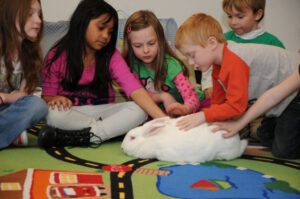Article:
Humane Education: A Critical Need
Sixty school shootings with 57 deaths and 150 injuries; 640 mass shootings; 830,000 violent school incidences; 770,000 juvenile arrests. Per year!
This is the society we live in. And the majority of violent crime is committed by young people under the age of 30. We educate them well in the arts and sciences, and they become our doctors, teachers, construction workers. If they make it that far.
What’s missing in our children’s education is the teaching of empathy, respect for others, humane principles. But humane education has been around for decades, hasn’t it? Isn’t it old news by now?
Some states have laws requiring humane education (H.E.). In NY, Section 809 of the Education Law requires it to be taught weekly at elementary grade levels. But many of NY’s teachers aren’t even aware that the law exists. In other cases, it is ignored. Efforts by NYSHA and others to force NY’s Education Department to comply were rebuffed. NY State simply won’t follow its own law.

Empathy and morality should be taught at home some people would argue. However, many families are unwilling or unable, and many children are too busy with social media to listen. And 700,000 school children live in abusive homes where they learn the opposite. Extensive research shows that unsafe home situations are the major breeding ground for future violent individuals.
Teachers are the “other authority figures” and influence in a child’s life beside their parents or guardians. Humane education taught by teachers could be a major antidote to the appalling violence statistics. To be effective, H.E. presentations should be made every week or two, either by the teachers or outside presenters.
Children’s natural fascination with and love of animals makes them respond well to messages of kindness and respect for them. Studies show that kindness and respect for animals carries over into kindness and respect for humans. Morality and sympathy toward people is taught by teaching morality and sympathy toward animals.
Teachers don’t even have to develop their own H.E presentations. There are literally thousands of lesson plans available from many professional organizations. If teachers prefer, several organizations will send guest presenters to their classrooms. (See NYSHA’s Humane Education Materials and also NYSHA’s links to other organizations’ educational materials.)
So, who would be the beneficiaries of humane education taught in schools?
- Children benefit. There would be less bullying, less school violence, fewer school shootings, fewer juvenile arrests, less future violent crime.
- Teachers benefit. Over 300,000 teachers are threatened in schools yearly and 180,000 are assaulted (9% of middle school teachers alone).
- Society benefits. There would be less juvenile crime and less violent crime overall, less domestic violence, fewer prison inmates, less animal cruelty, fewer mass shootings, less gun violence and murder.
- And there would be a dent in the hundreds of billions of dollars that violent crime costs society every year. Put simply, humane education works.
We have a choice. We can continue to suffer the incidences of crime, carry out trials for the accused, pay the huge medical and emotional costs of the victims, and incarcerate an endless stream of perpetrators, or we can take steps to reduce the staggering consequences that result. Can humane education stop all crime? Of course not. But humane education is one of the most powerful weapons in the arsenal of crime fighting, a tool to help reduce it, help prevent it in the first place.
More information, including the wide availability of H.E. programs and guest speakers, is available on the NYSHA website (see NYSHA’s Humane Education Materials and also NYSHA’s links to other organizations’ educational materials.) and from the writer at harold.hovel@aol.com.
This article was adapted from NYSHA Board Chairperson Harold Hovel’s April 2023 presentation to hundreds of teachers and school officials at a BOCES regional conference conducted via Zoom. His appearance was facilitated by NYSHA’s partnership with the Hyer Ground Rescue animal welfare organization.
What You Can Do:
- Find out if Humane Ed is being taught in your elementary school. If not, bring the NY law to the school authorities’ attention. (Section 809 of the Education Law)
- Let teachers and administrators know there are resources available, many on NYSHA’s website. Offer to help teachers find H. E. presenters.
- Let school guidance, social workers, and psychologists know that NYSHA’s booklet, The Connection Between Animal Abuse and Human Violence by Dr. Hovel, can be read online at NYSHA’s website or ordered.
- If there is no Humane Ed, ask to speak at a school board meeting. Have copies of the law to distribute.
New York State Humane Association Humane Review, Vol.XLII, Fall 2023.